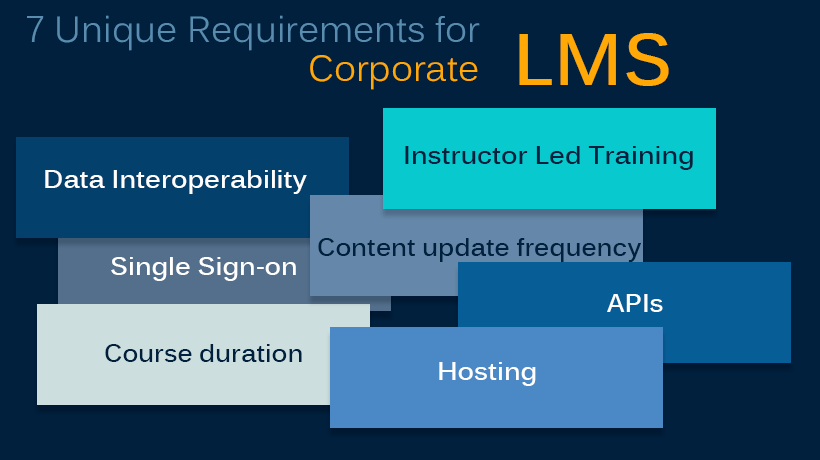Learning Management System Requirements That Small And Medium-Size Companies Look For
It’s that time of the year when we start hearing about how the past year went by and what is the forecast for the new year. The much-awaited reports of the year are just around the corner and blogs about the stats and trends have already started coming up – for the eLearning industry, as well as specifically for the Learning Management System (LMS) industry.
The Learning Management System software market is growing extremely rapidly. A few years back, Learning Management Systems were used within the reach of only large corporates. Fast forward today, there are hundreds of low-cost Learning Management System options available which are growing the Learning Management System adoption in small and medium-size companies.
Over the last decade, having worked with thousands of organizations of all sizes, across the world, we have been able to closely watch the Learning Management System challenges of these organizations. Not surprisingly, the challenges for the small and medium-size companies are quite different than those of the large corporates. When the large corporates have a dedicated IT team to manage the Learning Management System operations, the small companies need to manage the operations within the available staff.
Based on my interactions with hundreds of eLearning professionals and business owners, here is a list of Learning Management System requirements which I think the small and medium-size companies typically look for while choosing a Learning Management System.
- User Friendliness.
Difficulty in learning the system is one of the top 5 Learning Management System software challenges across all sizes of organizations. Especially for small organizations, when they don’t have too much time, skill sets, and budget for training on the new software, it is absolutely important that the Learning Management System software they choose is extremely easy to use and users are able to get started using it within no time. Although the Learning Management System technology is an old one, it is absolutely mandatory for the Learning Management System tools that the user interface and user experience match with the user experience which the users are used to on their mobiles phones and apps. Simple things such as the flexibility to log in using popular social channels is a given in today’s time and age. Elegant Learning Management System design can help in engaging the learners with the course material and also allow the eLearning creators to spend more time in creating courses rather than wasting their time in learning complicated Learning Management System features. - Flexible Payment Options.
Small and medium-size companies are generally pressed on budget and they don’t necessarily want to commit a huge investment right in the beginning. They need the flexibility of “Pay as you go” and options to upgrade or downgrade any time. Learning Management System tools which require investment and commitment right in the beginning may not be the best options for them because before making any investment, what they really want to ensure is that the tool of their choice fits into their requirements and works as per their expectations – not only on paper, but in the real environment. - Easy Configuration.
Learning Management System implementation budgets vary based on the size of the companies. While large organizations might be willing to spend millions of dollars and several months on the Learning Management System implementation, smaller companies might need the Learning Management System to be up and running within a matter of a week and with a budget of $500. Small companies can’t afford to disrupt the business operations during the Learning Management System implementations. It is, therefore, important that the Learning Management System they select is extremely easy to configure and setup – possibly with just a few setting and clicks and yes, this should be possible in today’s age of the cloud, right? - Customizations.
Who says that small companies need to compromise on the features and user interface just because they are short on budgets? The only difference is that the small companies need options to customize the Learning Management System as per their needs – in a very quick and easy way. It should be easy to turn on/ turn off the features, change the time zones and date formats, and white label the tool as per the company branding. Having said this, there should always be the flexibility to add new features which are required for the specific needs of the organization. - Ease Of Deployment.
Small companies definitely don’t want to spend time and money on building the Learning Management System infrastructure with hardware and software. They have neither the budgets nor the bandwidth for the same. They also don’t want to spend their time and money in the infrastructure management with upgrades, security, etc. I have seen that most of such companies have started exploring the cloud-based Learning Management System options which are offered as SaaS. SaaS gives them the flexibility to get started quickly – almost within a matter of few minutes, without worrying about the infrastructure. It’s should be as simple as logging into a website from the browser. - Data Security.
SaaS offering does not mean lack of data security. With the rising popularity and adoption of the cloud, a lot of measures are being taken for the data security on the cloud. All you need to do is just ensure that the vendor you select is sensitive about the data security and has implemented the measures such as separate databases for each customer and SSL encryptions. - Avoiding The Feature Overload.
I was recently reading about an interesting psychological concept called “the paradox of choice”. According to this concept, the more choices we have, the less happy we are with the choices that we make. I think the same applies to the applications which we use. The more features any product offers, the less happy we are while using it. I have seen that many Learning Management Systems try to sell the number of features they offer. Well, as a user, I would say that instead of focusing on hundreds of features, why not focus on which ones you really need and see if the Learning Management System offers those useful features or not? I feel that apart from the regular features, some of the other important features which the Learning Management System must offer include SCORM compliance, custom reporting, scheduling of reports, and eCommerce. - Support.
No matter how well-versed you are with software implementations, you are going to need a little support to get started with using the Learning Management System. As a small or medium-size company, you should not be deprived of the attention which you richly deserve. When you choose the Learning Management System vendor, do check for the Learning Management System documentation, knowledgebase, and availability of online tutorials. Availability of a 24 X 7 support will be an icing on the cake!
I would be keen to know your views on the challenges you faced during your Learning Management System implementations. Do share your thoughts.








